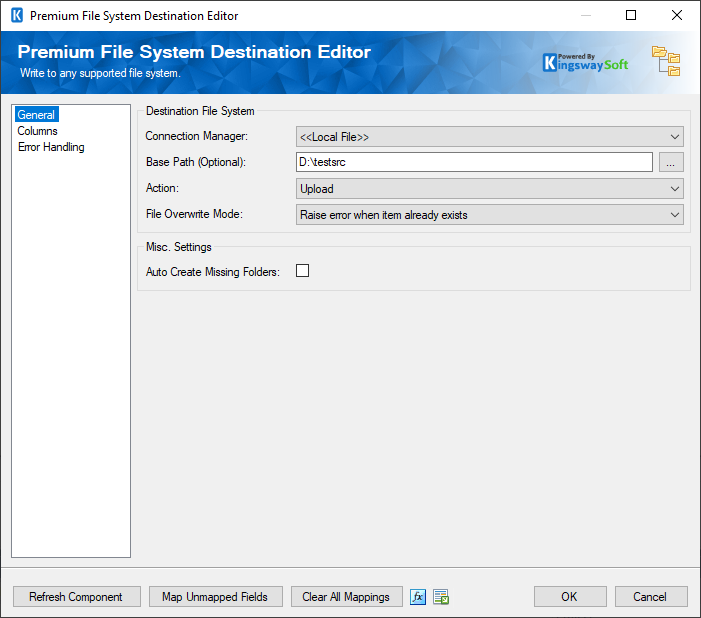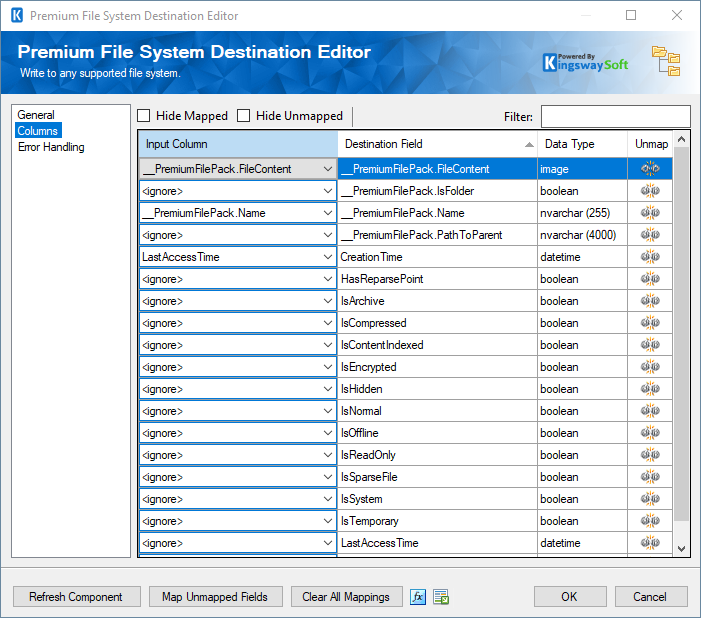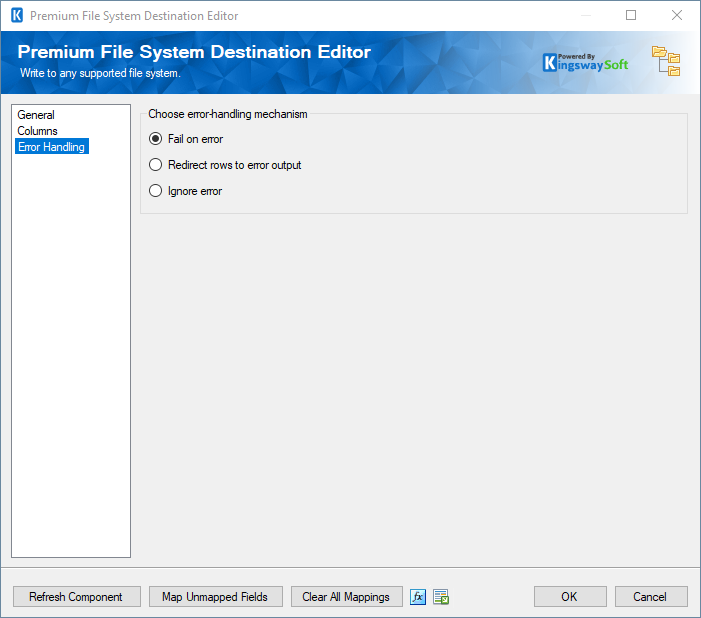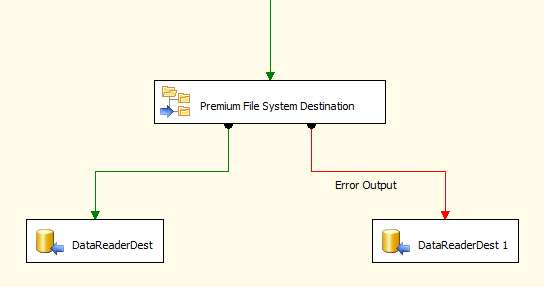Using the Premium File System Destination Component
The Premium File System Destination component is an SSIS data flow pipeline component that can be used to write data to a File System. There are three pages of configuration:
- General
- Columns
- Error Handling
The General page is used to specify general settings for the Premium File System Destination Component. The Columns page is used to manage columns from the upstream component. The Error Handling page allows you to specify how errors should be handled when they occur.
General page
The General page allows you to specify general settings for the component.

- Destination File System
-
- Connection Manager
-
The Premium File System Destination Component requires a connection. The Connection Manager drop-down will show a list of available connection managers:
The following connection managers are supported:
- Local File
- FTPS Connection Manager
- SFTP Connection Manager
- Amazon S3 Connection Manager(since v20.1)
- Azure Blob Connection Manager(since v20.1)
- Azure Data Lake Storage Connection Manager(since v20.1)
- Azure Files Connection Manager(since v20.1)
- Box Connection Manager(since v20.1)
- Dropbox Connection Manager(since v20.1)
- Google Cloud Storage Connection Manager(since v20.1)
- Google Drive Connection Manager(since v21.2)
- Hadoop Connection Manager(since v20.1)
- OneDrive Connection Manager(since v20.1)
- SharePoint Connection Manager (since v22.1)
- WebDAV Connection Manager(since v20.1)
- Base Path (Optional) (since v22.1)
- The base file or folder path can be specified.
- Action
-
The Action specifies how you want to write to the file system specified in the selected Connection Manager. There are four Actions:
- Upload: Uploads files and creates folders
- Move: Move files and folders from 1 folder to another
- Delete: Deletes specified items
- Copy: Copy the specified items
- File Overwrite Mode
-
The File Overwrite Mode specifies how to handle items that try to upload that already exist in the target system. There are 4 Modes:
- Overwrite existing item
- Skip when item already exists
- Auto increment item name: Increments the file name followed by the Auto Increment Format String setting if the file name exists at the specified PathToParent location.
- Raise error when item already exists
- Auto Increment Settings
- Auto increment Format String
-
Specify the format for the auto-incremented file name.
- Misc. Settings
-
Auto Create Missing Folder: This option can be checked in order to auto-create a missing folder in the Target location.
- Map Unmapped Fields Button
-
By clicking this button, the component will try to map any unmapped attributes by matching their names with the input columns from upstream components.
- Clear All Mappings Button
-
By clicking this button, the component will reset (clear) all your mappings in the destination component.
- Expression fx Icon
Click the blue fx icon to launch SSIS Expression Editor to enable dynamic updates of the property at run time.
- Generate Documentation Icon
Click the Generate Documentation icon to generate a Word document that describes the component's metadata including relevant mapping, and so on.
Columns page
The Columns page of the Premium File System Destination Component allows you to map the columns from upstream components to the Premium File System Fields.
In the Columns page, you would see a grid that contains four columns as shown below.

- Input Column: You can select an input column from an upstream component for the corresponding Premium File System Field.
- Premium File System Field: Specifies how to write the current item to the specified File System.
- Data Type: This column indicates the type of value for the current field.
- Unmap: This column can be used to unmap the field from the upstream input column, or otherwise it can be used to map the field to an upstream input column by matching its name if the field is not currently mapped.
Error Handling page
The Error Handling page allows you to specify how errors should be handled when they happen.

There are three options available.
- Fail on error
- Redirect rows to error output
- Ignore error
When the Redirect rows to error output option is selected, rows that failed to write to the File System will be redirected to the 'Error Output' output of the Destination Component. As indicated in the screenshot below, the blue output connection represents rows that were successfully written, and the red 'Error Output' connection erroneous represents rows. The 'ErrorMessage' output column found in the 'Error Output' may contain the error message that was reported by the server or the component itself.


